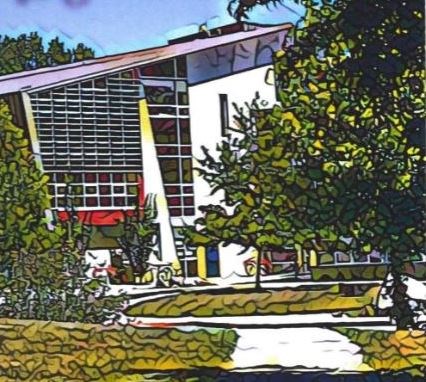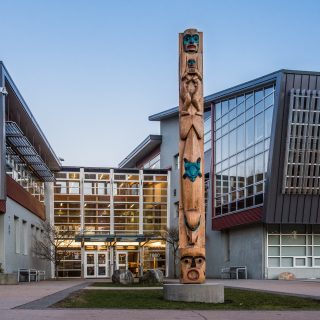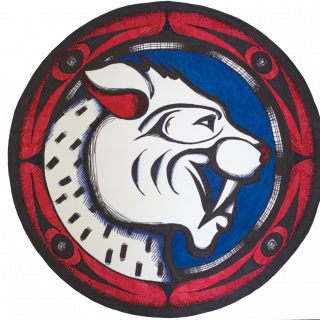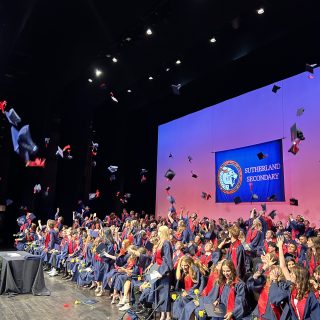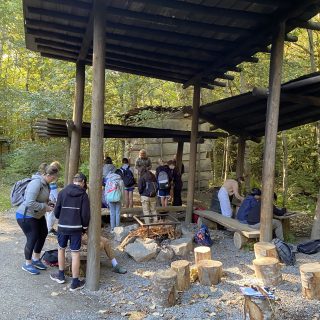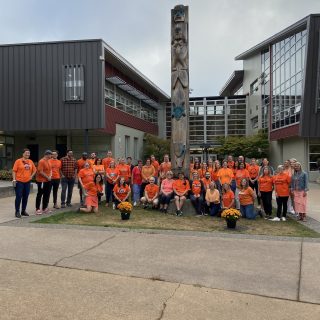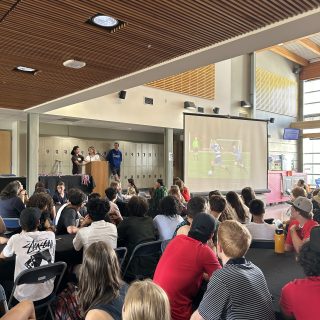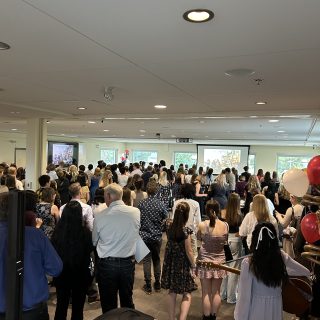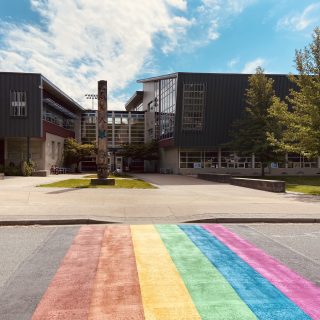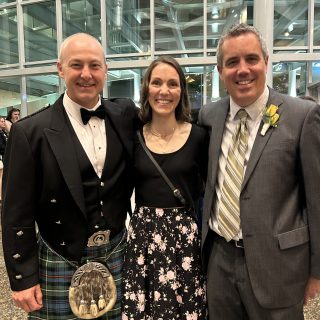Vision to Goal Setting
What is our Vision for Learning?
What is our raison d’etre? The visioning process encompasses reflecting on our core mandate and purpose, articulating our guiding beliefs and shared values, and setting goals for a preferred future. In the North Vancouver School District, we envision a school-based engagement process that highlights the strengths in our school community while identifying areas for future focus and development.
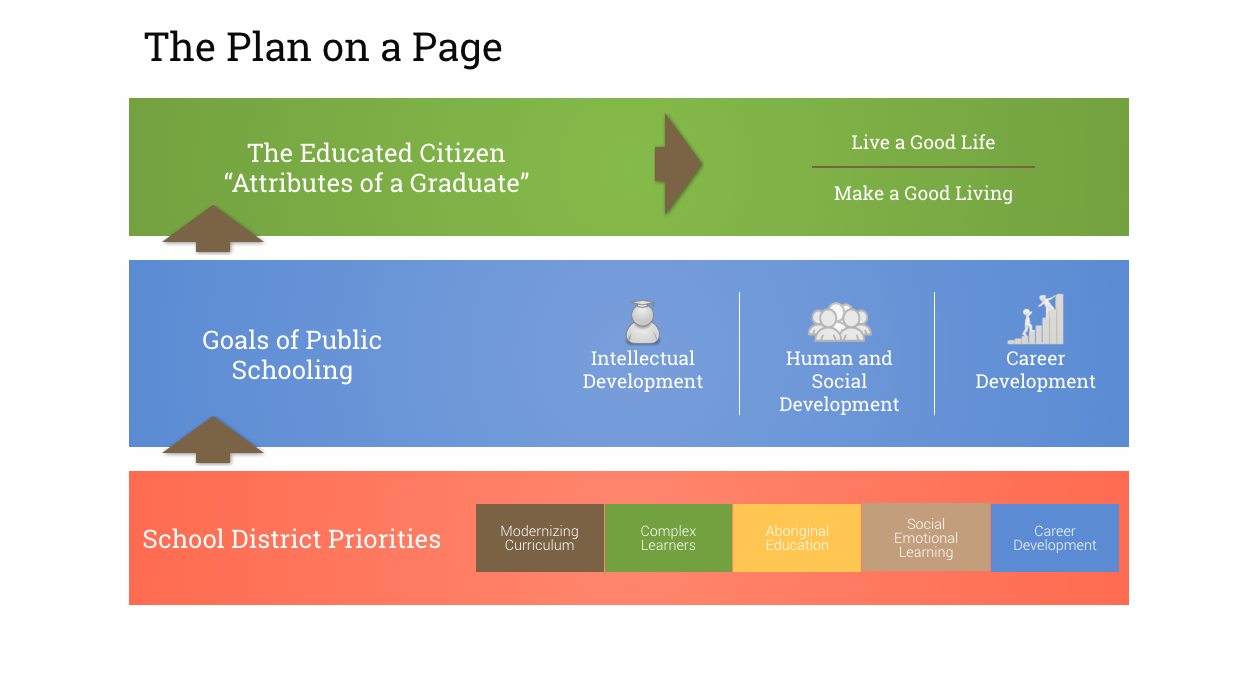
Consectatio Praestantiae - Striving for Excellence
Sutherland strives to develop students’ skills and intellects and provide opportunity for personal growth in a supportive, respectful learning environment. We endeavour to prepare students to become responsible citizens.
OUR PLANNING PROCESS: 2016-2024
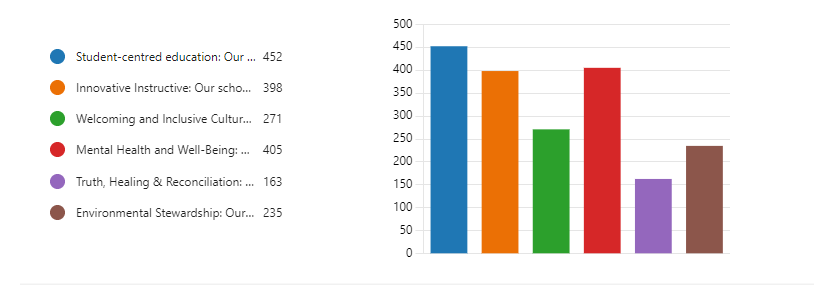
The Sutherland Community, including students, staff, and families, identified three goals for the 2022-23 school year: Learning, Belonging, and Well-being. As in previous years, Sutherland Secondary continued to focus on the elements of the Districtâs Strategic Plan with a particular emphasis on those that aligned with goals identified by our community. These goals provided guidance for many endeavours undertaken by Sutherland over the course of the 2022-2023 school year.Â
The current year’s goals were identified by a diverse group of stakeholders though a thoughtfully planned School Survey. As we implemented the 2022-23 goals, the school leadership team was simultaneously partnering with Sutherland’s Teacher Leaders and community members to fine tune the content and questions for the next year survey. This planning process began in October; in February, over 650 students and families completed the School Planning Survey to share their opinions and feedback on how Sutherland had done on the current year’s goals and what they wanted to see as key focus areas for the school in the 2023-24 school year. New this year was the addition of connection and collaboration across the NVSD regarding school goals and planning processes.
The responses gathered from students and families regarding goals for next year clearly call for a continued focus on student Mental Health and Well-being. The other two goals are similar to this year’s focal points of Belonging and Learning: students and families want to see additional emphasis on Student-Centred Learning and Innovative Instruction. With this information in hand, Sutherland administration and staff are ready to begin thoughtfully planning lessons, activities, guest speakers, professional development, and community events that will forward the goals our school community has identified.
2021-2022 was a year of new beginnings for Sutherland Secondary and one of our key areas to focus was to update the School Plan to align with the Districtâs new Strategic Plan, to reflect the current needs of our students, and to better represent the goals of our school community. Key to the process of updating our school goals was to hear from the students and ensure their voices were at the forefront.
As a school leadership team and broader school planning team (including parents, staff, and students) we met to fine tune the content and questions for a school-wide student survey around updating the School Plan. Although COVID, once again, stalled the process, by March, students were given the opportunity to complete the survey, adding their opinions and feedback on what they wanted to see as key focus areas for the school. We had just under 650 students respond to the survey and through the process of collating the data, were able to update, change, and add new goals and objectives to our School Plan.
Coming out of a year interrupted by COVID, we are keenly aware of the need to focus on student Mental Health and well-being and the students echoed this in their survey feedback. This is a new goal for Sutherland. The other two goals around Belonging and Learning remain, but have been updated to reflect the feedback from students and the school planning team.
Â
The 2020-2021 school year was like no other anyone has experienced. The COVID-19 pandemic caused everything to change â the school schedule, the delivery of instruction, how we interacted, where people could be in the school â everything changed.
Particularly at a time when the whole world was experiencing a collective feeling of disconnectedness, the team at Sutherland put great focus on our goal of strengthening the sense of belonging within the school community for students and for staff. At the forefront of our planning this year was to ensure we were all working through a lens of compassion, care, and flexibility. Students and staff were all experiencing the COVID-19 Pandemic in unique ways, working through anxieties and unique circumstances to varying degrees. This meant that we needed to be mindful of peoples entry points as they entered the building or re-engaged with learning. We focused on ensuring students and staff felt a sense of comfort when they were at the school – that they were safe, cared for, heard, and seen. The ability to communicate to students through MS Teams allowed for a greater sense of connection – even when in-person classes were running every other day, allowing for regular check-ins with students. Our staff created a Wellness Team with the overarching goal of ensuring that every person in our School had time and space to focus on well-being. We knew that if the adults in the school were prioritizing wellness, then this would disseminate through to our students. As we continue this work, we want to ensure that mental health, wellness, and well-being is being considered and cared for in every classroom at Sutherland.
Even with a deep focus on the social and emotional well-being of staff and students, our focus on growth in curriculum, assessment, and instruction continued to evolve and strengthen this year. With a shift to Hybrid learning for our Grade 9 to 12 students and to classes running on a quarter system, staff were in a unique position to completely shift teaching practices to support learning and to focus on curriculum, assessment, and instruction in innovative new ways. Many of the strategies will definitely continue on even when we return to schooling in a more normal way. We witnessed a real focus on Big Ideas and on Curricular Competencies that were essential to learning and understanding. While we maintained high and motivating expectations for all learners, staff were able to differentiate to meet the needs of all learners through more inquiry and project-based learning. The hybrid model also allowed for increased opportunities for formative assessments along students learning paths.
The plan for 2020-21 had been to build upon our renewed goals developed early in the 2019-20 school year. The disruption to education that has occurred since the spring of 2020 has left us with many new skills and strategies for teaching and learning that were not foreseen just two years ago. Moving into the 2021-22, we will continue to build upon the innovative practices that grew out of the shift in education during pandemic teaching. We will look to revise our goals and rewrite objectives to better align with our time and place and preparing our students for success within, beyond and outside of their formal Secondary School experience.
For 2019-20, the 5th year of the current School Planning process, the Sutherland Staff worked to renew our goals, focusing our commitment and efforts on student achievement, connection and well-being. We started the school year by embarking on a dialogue process to narrow the themes and to identify specific targets within, as well as markers of progress to indicate our effectiveness in each area. Professional Learning Communities were then formed, and much work carried out, but unfortunately the interruption caused by the timing of the COVID-19 health crisis and the move to remote learning prevented the completion of a few important steps in the plan for this year. We look forward to continuing our work on the new goals in 2020-21, adding in findings and strategies gained learned from the PLC project work that has taken place, and additional consultation with all school stakeholders to continue to move forward. We are also appreciative of the many advances in learning that have come out of the sudden shift to online learning â some of which are closely linked to our School Plan – and have added some reflections and information collected into our plan.
The 2018-19 school year was a year of transition at Sutherland with a fully new administrative team and a 20% staff turnover. While the new curriculum at grade 8 and 9 rolled into its second year of full implementation, staff continued to explore and work with the new grade 10-12 curriculum ahead of its full implementation for 2019-20. As part of goal #1, assessment practices have also been reviewed and adjusted to better align with the revised curriculum as classroom based assessments are given a higher profile in overall assessment and provincial assessments increasingly used as a snapshot in time.
The 2017-18 school year saw the full implementation of the revised curricula at the grade 8 and 9 levels. Through staff collaboration and professional development day presentation, Sutherland staff continued with rich dialogue and action on the goals identified in the previous year plan. As implementation of the revised curricula begins for grade 10 in September 2018, individual departments focused on the possibilities that the school potentially can offer around 2 credit courses. Other areas of significant effort involved Student Self-Assessment and Communicating Student Learning.
Student Self-Assessment: The Sutherland staff effort to implement student self-assessment was significant. Over the course of the year much staff collaboration time was devoted to developing a process that would result in meaningful self-assessments in a streamlined process. Many staff members developed their own unique processes around the Core Competencies and implemented them in a variety of ways as part of their regular formative assessment practices. During the last week off April, students in grades 8 to 11 completed the student self-assessments during FOCUS block.
A significant effort at Communicating Student Learning was also made this past year in alignment with ministerial and district policy.
Plans for directing the school plan for next year will be made by the incoming school principal. An area of focus would be around gaining greater student/parent input and developing a plan for data collection and analysis to determine efficacy of the plan.
School Plan 2017-2018 Action Plan
Goal 1a: The Revised Curriculum
In the 2017-2018 school year, Staff will continue to implement the revised curriculum at the grade 8 and 9 level. During this time, staff will also have the year to continue development and discussion around new course offerings at the grade 10-12 levels.
Professional Learning Communities â How to proceed, status quo or a change up in PLC grouping? Changing PLC groups would allow staff to engage in another aspect of the revised curriculum and expand their repertoire.
Phase three of the school plan will reflect the involvement of students and parents as part of the School planning team.
Goal 1b: Core Competencies and Student Self-Assessment
Developing a continued awareness and application of the Core-Competencies in all curricular subject areas. Lesson plans should reflect the vocabulary of the core-competencies, as students will be required to reflect and self-assess their learning in respect to the competencies.
Goal 2a: Student Well Being
Continued staff exploration of themes/speakers/programs to support studentâs social-emotional needs.
Implementation of SOGI 1 2 3 resources.
Involving parents and more staff in the Mental Health Curriculum.
Goal 2b: Sutherland Family of Schools Connections (FOS)
Continue to develop staff relationships between the Sutherland FOS. Collaborating around Professional and Curriculum Training Days. Continue to explore/expand the Grade 7 Articulation process.
Schools are foundational to creating society and the shared values that bind us together. A great school is often described as a community of learners including students, teachers, support staff, parents and community members. Engaging the community of learners in recognizing the many quality attributes of the school while highlighting future directions and areas of focus is the intention behind school planning.
Historically, in British Columbia, school planning has taken a couple of different forms. Pre 2002, the school accreditation process that included an external team assessing the work of the school was the primary method to enable school planning. From 2002 to 2015, each school community was asked to develop a school growth plan. Unfortunately, the school growth plan movement was not designed in a collaborative manner, it was solely achievement oriented, and as such did not engender commitment from the full community of learners.
Moving forward, SD 44 has embarked on a process to define and develop a more authentic school planning process that reflects the values of individual communities while maintaining a commitment to the Mandate of Public Schooling.
Design Process from March 2015 to July 2015, in consultation with representative School Planning Councils and student leaders, a team of educators that included teachers, Educational Assistants, School Principals and Directors worked together to define the role, purpose and direction of the school planning process. The working group developed shared understanding and general processes as the initial foundation to meaningful school planning. Meaningful school planning should enable the development of a vibrant community of learners defined by:
- A focus on student engagement and learning
- A culture of teamwork and collaboration
- Respect of adult and student diversity
- As strong sense of community and collective responsibility
- Strong Systemic Structures (e.g. SBRT, Collaboration Time, Staff Meetings)
- Ongoing and relevant communication of student learning
- *NVSD School Planning Discussion Paper
Planning & Implementation
What is our Action Plan?
To create unique and authentic learning experiences that reflect diverse student needs and are varied, dynamic, and engaging.
- through lessons and units created with a universal design (UDL) that acknowledge and teach to diversity
- through engaging subject matter and teaching practices
- through innovative teaching strategies and assessments
- through Indigenous Ways of Knowing
- through connecting learning to real-world experience and practical skills
- through ongoing meaningful self-assessment of the Core Competencies
- through strong Career instruction, mentorship, and community connections
- through providing adequate support along with adequate challenge
To champion and support students’ individual goals, needs, and motivations, and to provide choice and flexibility in learning opportunities and assessments.
- through amplifying student voice and offering myriad opportunities for students to be heard
- through emphasizing student strengths and designing lessons and assessments that provide choice
- through building an inclusive environment through spreading awareness of and celebrating a variety of cultures, events, and perspectives
- through increasing the integration of Indigenous knowledge and perspectives in the school
- through increased representation and recognition of success for diverse groups within the school
- through fostering a caring environment and greater personal connections between staff, students, and community members
To support mental health and well-being at school in order to produce positive relationships with ourselves, each other, and the environment.
- through fostering compassionate, inclusive learning environments
- through creating an increasingly inclusive and vibrant school culture through school spirit, ensuring all students feel they have a place within the school and are an important member of the Sutherland community
- through trauma-informed practice
- through building a variety of wellness resources and promoting them among the school community
- through connecting mental health instruction to the curriculum to build understanding and resilience
- through creating more accessible safe spaces in the school
- through forming multiple pathways for community members to reach out, express ideas, and receive help
Monitor Evaluate & Adapt
What are our Indicators of Progress?
2023-2024:
Throughout this academic year, our objectives in Innovative Instruction, Student-Centered Learning, and Well-being were implemented through collaborative efforts involving students, staff, administration, and parents. Significant strides were made across these domains. There were notable efforts to enhance inclusivity through initiatives such as Black History Month, Inclusive Education Month, Pride Month, Transgender Day of Remembrance, and Indigenous First Peopleâs Day.
Our daily announcements became more diverse, we introduced an inclusive music block for students in LSC, alongside expanded athletic opportunities catering to both competitive and non-competitive interests. Moreover, our students had the opportunity to participate in a wide array of clubs, fostering social connections and positive relationships with peers and staff.
Recognizing the financial challenges faced by some families, due to inflation and rising living costs, Sutherland increased its food access programs, including initiatives like the Banana Club, Immigrant Link Society, and Best Buddies, complemented by a spring clothing swap.
Emphasizing mental health across our school community, initiatives were integrated into counseling services, Physical and Health Education (PHE) classes, and Career Life Education (CLE) and Career Life Connections (CLC). Notably, many grade 12 students selected health and well-being topics for their Capstone Projects.
Perhaps the most significant achievement was Sutherlandâs No Cell Phone Policy, a collaborative effort involving students, staff, administrators, and families. This policy restricted phone use during instructional time, yielding positive academic and social outcomes across all grade levels. Students reported heightened concentration and increased participation in classroom discussions. The success of Sutherlandâs policy served as a model, influencing similar measures district-wide.
In the tabs below, you will see that Sutherland’s goals are centred around our school theme, “Pride, Passion, Place.” This theme informs the various ways in which we implement our school goals. It has become the cornerstone of the work we do. It deepens our commitment and holds us accountable to our own high standards for education. Please click on the tabs for more information on each goal.
2022-2023: As in previous years, the implementation of our goals for 2022-23 occurred in conjunction with information-gathering on our progress and planning for the focal areas for the coming school year. We regularly revisited our progress on our current goals of Learning, Belonging, and Well-being as we looked ahead to areas for growth for the future. Through consistent consultation during the year with our students, staff, and families, the Sutherland Administration and Teacher Leaders have identified the main areas where we will devote our energies next year. The goals for 2023-24 are framed in alignment with the District’s Strategic Plan, but maintain much of the same theme as Sutherland’s goals for the previous two years. Next year, we will focus on Innovative Instruction, Student-Centred Learning, and Mental Health and Well-being.
2021-2022: Seeking to update the School Plan to align with the Districtâs new Strategic Plan and to better reflect the current needs of our students, we set-out to gather information that we could synthesize together with the learnings of the previous two years, to update and create a plan that is meaningful to our current time and community. It was critical to the process of updating our school goals that we ensured student voices was at the forefront. To capture this voice, the school planning team developed a school-wide student survey, which, after just under 650 students completed, provided opinions and feedback from the student perspective for what they wanted to see as key focus areas for the school.
Coming out of a year interrupted by COVID, we are keenly aware of the need to focus on student Mental Health and well-being and the students echoed this in their survey feedback. Based on this feedback and recognizing the success we have achieved in our previous “connections” goal, we moved elements of the previous goal into “learning” and created the new goal of Well-being. The other two goals around Belonging and Learning remain, but have been updated to reflect the feedback from students and the school planning team.
2020-2021: The sudden move to remote learning in the Spring of 2020 interrupted our next steps for fully adopting the newly revised school goals both within and across department planning, it did create an unplanned and unique, though forced, opportunity to innovate. While the schedule for implementing action items to enhance Learning, Belonging, and Connections at Sutherland was interrupted, still, great progress was made and many specific tasks completed. Moving into 2020-21, with the uncertainty and trepidation that came with in-person learning during a pandemic, the necessity for flexibility, adaptation and innovation with the need to create authentic opportunities for student engagement more than ever, became our focus. Below are our themes as we reflect on the learnings from the COVID era of instruction and learning, some reflections taken from our staff capture in June 2020, as well as summaries of the progress and achievements of some of our PLC groups. In addition to the PLC work described below, a Code of Conduct Review has been completed, and work is ongoing in Cross-Curricular Collaboration and Indigenizing our Space.
Innovative Instruction: Pride
At Sutherland Secondary, teachers take pride in their job and offer innovative instruction to inspire and engage students. To support diverse learning styles and preferences, Teacher Leaders underwent professional development focused on Universal Design for Learning (UDL). Additionally, staff dedicated time through collaboration days and meetings to master the Ministry’s new proficiency scale assessment. There was a focus of creating opportunities and practical skills outside of the classroom post-graduation, the Physical and Health Education (PHE) department piloted a CPR training and certification program taught by the North Vancouver Fire Department. For career readiness, Grade 12 students participated in a job interview event with members of the district HR and community. Furthermore, our commitment to Indigenous education was highlighted through the Moosehide Campaign, which raised awareness and aligned with our priority of incorporating Indigenous ways of knowing into our curriculum.
Student-Centered Learning: Passion
Our commitment to passion has driven us to cultivate a student-centered environment that prioritizes engagement and celebrates individuality. We have amplified student voices through numerous opportunities that encourage exploration of their strengths and interests. Lessons and assessments have been designed to offer choices, accommodating diverse learning styles and preferences across all grade levels. In our younger classrooms, teachers actively inspire students to demonstrate their knowledge in ways that spark creativity and align with their personal interests. Meanwhile, senior students undertook the challenge of a Capstone Project, empowering them to delve deeply into their passions and take ownership of their educational journeys. Beyond academics, the Sabre Council has evolved to include representatives from all school clubs, ensuring that student perspectives from various interests shape our school‘s policies and decisions. Our student-centered focus has fostered an inclusive environment that promotes awareness of and celebrates a wide range of cultures, events, and perspectives, enriching the fabric of our school community.
Mental Well-being: Place
This year, we focused on enhancing student well-being under the overarching theme of place. Most notably, in an effort to support students’ mental well-being, we implemented a cell phone ban during class times, fostering an environment that promotes focused learning and reduces distractions. In addition to this, we dedicated resources to supporting students, to ensure every student and staff feel valued and supported in their personal and educational growth. There was also an increased focus on well-being within content classrooms, the launch of a successful smoking/vaping cessation program, included community partners and expert guest speakers in staff and student gatherings, and the revitalization of Sutherlandâs Diversity Club. These initiatives reflect our commitment to creating a positive and nurturing ‘place’ where students can thrive academically, socially, and emotionally. Together, we continue to innovate and evolve to meet the needs of our diverse student body.
Communicating Progress
How do we Communicate our Progress?
The school planning process is intended to support an ongoing dialogue within the community of learners to promote understanding, respect, and shared values. Communicating the vision, values, accomplishments, and future directions enable dialogue. Ultimately, schooling is a foundation to democracy and prepares students to be engaged citizens. An important feature within a community of learners is continual communication about what we value most.
Over the course of the school year we will communicate good news stories and community building events happening at Sutherland. As well, we will endeavour to communicate the progress of our goals. Communication will include:
- Updates to the school website, Twitter, and Instagram accounts
- Monthly Sutherland newsletter
- Administration report and presentations from staff and students at PAC meetings
- Student grade assemblies
- Updates to the online School Plan

